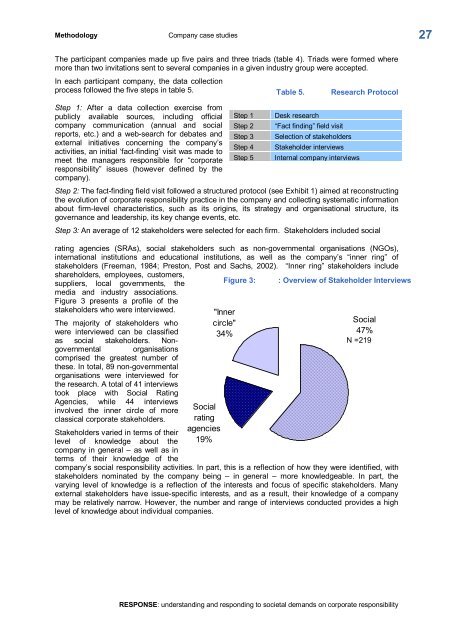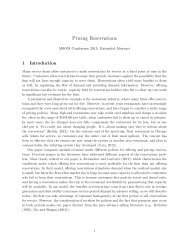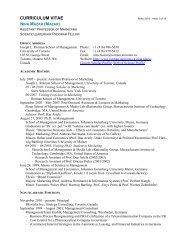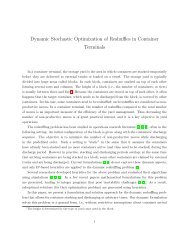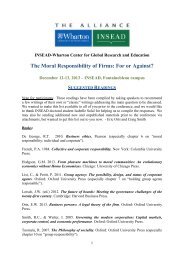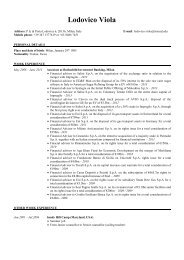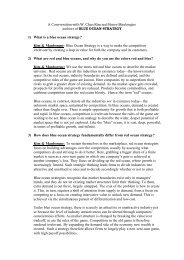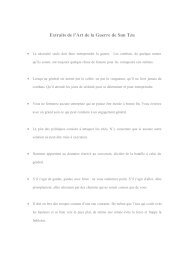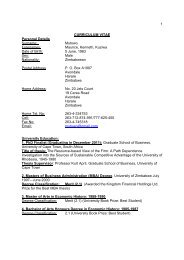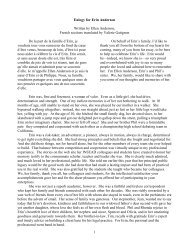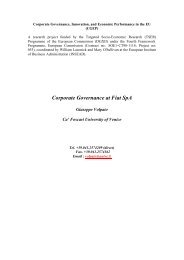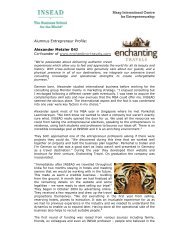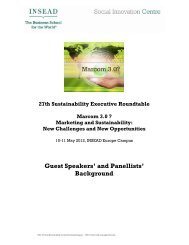RESPONSE - Insead
RESPONSE - Insead
RESPONSE - Insead
Create successful ePaper yourself
Turn your PDF publications into a flip-book with our unique Google optimized e-Paper software.
Methodology Company case studies<br />
The participant companies made up five pairs and three triads (table 4). Triads were formed where<br />
more than two invitations sent to several companies in a given industry group were accepted.<br />
In each participant company, the data collection<br />
process followed the five steps in table 5.<br />
Step 1: After a data collection exercise from<br />
publicly available sources, including official<br />
company communication (annual and social<br />
reports, etc.) and a websearch for debates and<br />
external initiatives concerning the company’s<br />
activities, an initial ‘factfinding’ visit was made to<br />
meet the managers responsible for “corporate<br />
responsibility” issues (however defined by the<br />
company).<br />
Step 2: The factfinding field visit followed a structured protocol (see Exhibit 1) aimed at reconstructing<br />
the evolution of corporate responsibility practice in the company and collecting systematic information<br />
about firmlevel characteristics, such as its origins, its strategy and organisational structure, its<br />
governance and leadership, its key change events, etc.<br />
Step 3: An average of 12 stakeholders were selected for each firm. Stakeholders included social<br />
rating agencies (SRAs), social stakeholders such as nongovernmental organisations (NGOs),<br />
international institutions and educational institutions, as well as the company’s “inner ring” of<br />
stakeholders (Freeman, 1984; Preston, Post and Sachs, 2002). “Inner ring” stakeholders include<br />
shareholders, employees, customers,<br />
suppliers, local governments, the<br />
media and industry associations.<br />
Figure 3 presents a profile of the<br />
stakeholders who were interviewed.<br />
The majority of stakeholders who<br />
were interviewed can be classified<br />
as social stakeholders. Non<br />
governmental organisations<br />
comprised the greatest number of<br />
these. In total, 89 nongovernmental<br />
organisations were interviewed for<br />
the research. A total of 41 interviews<br />
took place with Social Rating<br />
Agencies, while 44 interviews<br />
involved the inner circle of more<br />
classical corporate stakeholders.<br />
Stakeholders varied in terms of their<br />
level of knowledge about the<br />
company in general – as well as in<br />
terms of their knowledge of the<br />
Social<br />
rating<br />
agencies<br />
19%<br />
Table 5. Research Protocol<br />
Step 1 Desk research<br />
Step 2 “Fact finding” field visit<br />
Step 3 Selection of stakeholders<br />
Step 4 Stakeholder interviews<br />
Step 5 Internal company interviews<br />
Figure 3: : Overview of Stakeholder Interviews<br />
"Inner<br />
circle"<br />
34%<br />
Social<br />
47%<br />
N =219<br />
company’s social responsibility activities. In part, this is a reflection of how they were identified, with<br />
stakeholders nominated by the company being – in general – more knowledgeable. In part, the<br />
varying level of knowledge is a reflection of the interests and focus of specific stakeholders. Many<br />
external stakeholders have issuespecific interests, and as a result, their knowledge of a company<br />
may be relatively narrow. However, the number and range of interviews conducted provides a high<br />
level of knowledge about individual companies.<br />
<strong>RESPONSE</strong>: understanding and responding to societal demands on corporate responsibility<br />
27


